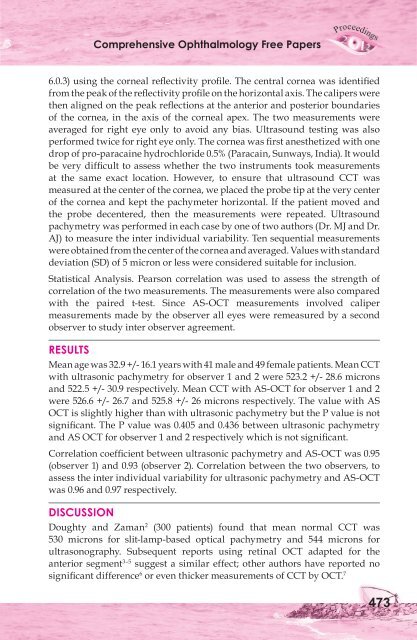Comprehensive Ophthalmology Free Papers - aioseducation
Comprehensive Ophthalmology Free Papers - aioseducation
Comprehensive Ophthalmology Free Papers - aioseducation
Create successful ePaper yourself
Turn your PDF publications into a flip-book with our unique Google optimized e-Paper software.
<strong>Comprehensive</strong> <strong>Ophthalmology</strong> <strong>Free</strong> <strong>Papers</strong><br />
6.0.3) using the corneal reflectivity profile. The central cornea was identified<br />
from the peak of the reflectivity profile on the horizontal axis. The calipers were<br />
then aligned on the peak reflections at the anterior and posterior boundaries<br />
of the cornea, in the axis of the corneal apex. The two measurements were<br />
averaged for right eye only to avoid any bias. Ultrasound testing was also<br />
performed twice for right eye only. The cornea was first anesthetized with one<br />
drop of pro-paracaine hydrochloride 0.5% (Paracain, Sunways, India). It would<br />
be very difficult to assess whether the two instruments took measurements<br />
at the same exact location. However, to ensure that ultrasound CCT was<br />
measured at the center of the cornea, we placed the probe tip at the very center<br />
of the cornea and kept the pachymeter horizontal. If the patient moved and<br />
the probe decentered, then the measurements were repeated. Ultrasound<br />
pachymetry was performed in each case by one of two authors (Dr. MJ and Dr.<br />
AJ) to measure the inter individual variability. Ten sequential measurements<br />
were obtained from the center of the cornea and averaged. Values with standard<br />
deviation (SD) of 5 micron or less were considered suitable for inclusion.<br />
Statistical Analysis. Pearson correlation was used to assess the strength of<br />
correlation of the two measurements. The measurements were also compared<br />
with the paired t-test. Since AS-OCT measurements involved caliper<br />
measurements made by the observer all eyes were remeasured by a second<br />
observer to study inter observer agreement.<br />
RESULTS<br />
Mean age was 32.9 +/- 16.1 years with 41 male and 49 female patients. Mean CCT<br />
with ultrasonic pachymetry for observer 1 and 2 were 523.2 +/- 28.6 microns<br />
and 522.5 +/- 30.9 respectively. Mean CCT with AS-OCT for observer 1 and 2<br />
were 526.6 +/- 26.7 and 525.8 +/- 26 microns respectively. The value with AS<br />
OCT is slightly higher than with ultrasonic pachymetry but the P value is not<br />
significant. The P value was 0.405 and 0.436 between ultrasonic pachymetry<br />
and AS OCT for observer 1 and 2 respectively which is not significant.<br />
Correlation coefficient between ultrasonic pachymetry and AS-OCT was 0.95<br />
(observer 1) and 0.93 (observer 2). Correlation between the two observers, to<br />
assess the inter individual variability for ultrasonic pachymetry and AS-OCT<br />
was 0.96 and 0.97 respectively.<br />
DISCUSSION<br />
Doughty and Zaman 2 (300 patients) found that mean normal CCT was<br />
530 microns for slit-lamp-based optical pachymetry and 544 microns for<br />
ultrasonography. Subsequent reports using retinal OCT adapted for the<br />
anterior segment 3–5 suggest a similar effect; other authors have reported no<br />
significant difference 6 or even thicker measurements of CCT by OCT. 7<br />
473

















